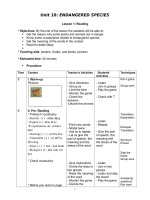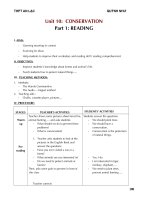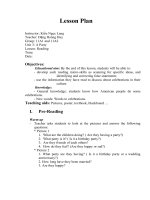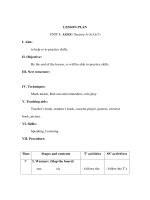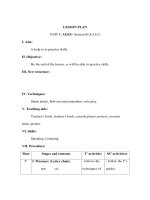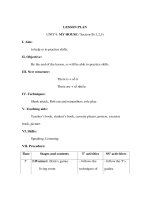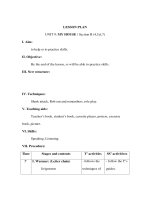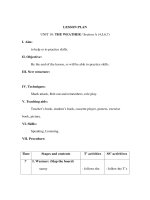LESSON PLAN -UNIT 10
Bạn đang xem bản rút gọn của tài liệu. Xem và tải ngay bản đầy đủ của tài liệu tại đây (86.39 KB, 12 trang )
THPT AN LẠC QUỲNH NHƯ
Unit 10: CONSERVATION
Part 1: READING
I. AIMS:
- Guessing meaning in context
- Scanning for ideas
- Help students to improve their vocabulary and reading skill ( reading comprehension)
II. OBJECTIVES:
- Improve students’s knowledge about forests and animal’s life.
- Teach students how to protect natural things.....
III . TEACHING METHODS:
1. Methods:
- The Mainly Communitive
- The Audio – Lingual method
2. Teaching aids :
- Chalks, cassette player, pictures…
IV. PROCEDURE:
STAGES TEACHER’S ACTIVITIES
STUDENTS’ ACTIVITIES
Warm
up
Pre
reading
Teacher shows some pictures about forest fire,
animal hunting ,... and asks students.
- What should we do to prevent these
problems?
- What is conversation?
1. Teacher asks students to look at the
pictures in the English Book and
answer the questions:
- Have you ever visited a zoo or a
forest?
- What animals are you interested in?
- Do we need to protect animals or
forests?
Then, asks some pairs to present in front of
the class
Teacher corrects
Students answer the questions
- We should plant trees
- We should have a
conservation.
- Conservation is the protection
of natural things.
- Yes, I do
- I am interested in tiger,
monkey, elephant, ...
- We need to plant trees,
prevent aninal hunting ....
108
THPT AN LẠC QUỲNH NHƯ
While
reading
Post
reading
2. Presenting new vocabulary:
* Teacher gives some pictures or some
definitionsto introduce new words
- Pro tection (n)
- Destruction (n)
- Pollution (n)
- Damage (n)
- Conservation (n)
- Environment (n)
* Teacher asks students give some word forms
of them
Teacher helps students to make examples
3. Pronouncing the vocabulary:
1. Model reading: cassette player
2. Reading:
Asks sts to read the text quickly in silence to
find the main ideas
* Task 1: Match the word in A with a
suitable definition in B
* Task 2: True or False
asks students to read the statements on page
106 then read the text and decide which is
true and which is false
* Task 3: Teacher asks students to choose the
most suitable main ideas for each paragraph.
Teacher corrects and explains
Asks students to answer the questions:
1. What is the consequence of losing forest?
2. How important is water in our life?
3. Vegetable can help conserve water?
Write these words down
Repeat after the teacher
Listen and look at the book
1c, 2a, 3d. 4b.
Read more carefully
1F, 2T, 3T, 4T, 5F, 6F.
Students explain
Sts work in pair to discuss the main
ideas for each paragraph
Then, each student is in font of the
class to present.
1. Paragraph B
2. Paragraph C
3. Paragraph A
Work in group to find the answers
1. The loss of much forests is
destroying the earth.
2. Man and most animals need a
constant supply of water to live.
Farmers need water for their crops.
3. We should stop polluting rivers and
seas and stop the disappearance of
plants and animals.
IV. HOMEWORK
- Learn the vocabulary
- Asks students to write a short paragraph about their solutions to prevent wild animal hunting in
109
THPT AN LẠC QUỲNH NHƯ
Viet Nam
Unit 10: CONSERVATION
Part 2: SPEAKING
I. OBJECTIVES
1. Educational aim: Students should contribute their parts to the protection of rare plants and
animals.
2. Knowledge
General knowledge: Through this unit, students learn about the functions of a new kind of
zoos.
Language: Sentences and expressions for talking about the new kind of zoos where rare plants
and animals are protected in their natural environment.
3. Skills: Fluency in expressing opinions and talking about the new kind of zoos where rare
plants and animals are protected in their natural environment.
II. METHOD: integrated, mainly communicative
III. TEACHING AIDS: pictures
IV. PROCEDURE
Teacher’s activities Students’ activities
Warm-up
Show a picture of a normal zoo and ask
questions:
1) What can you see in the picture?
2) Are the animals living in their natural
environment or are they kept in cages?
3) Do you think it’s good to keep animals in
cages?
Pre-speaking
T: Today we’re learning about a new kind of zoo
where animals can develop well. Look at your
books , task 1 (p106)
-Teacher reads the paragraphs aloud.
- Teacher explains the new words and
expressions the students have asked.
T: Read after me the new words and expressions
T: Look at your books and repeat after me the
paragraphs
Students’ answers
St: We can see a lot of animals.
St: They are kept in cages.
St: No, it isn’t. Because they can’t develop
well.
St: look at their books, listen to the teacher,
check the pronunciation and underline the
words or expressions they don’t understand.
St: pay attention to the teacher and ask the
teacher what they don’t understand.
St: look at the board and read the new words
and expressions.
St: Read after the teacher
110
THPT AN LẠC QUỲNH NHƯ
-Teacher calls on 4 students to read the
paragraphs aloud. (Each one reads half a
paragraph.)
- Teacher corrects the mistakes about
pronunciation.
T: Look at your books and read silently to find
out the answers to the questions.
T: Work with your partner: ask and answer the
questions.
- Teacher checks the answers by calling on
some pairs to ask and answer the questions.
While – speaking
T: When living in this new kind of zoo, animals
may have some advantages and disadvantages.
Look at task 2 (p 107) and do as directed
(teacher explains new words and expressions)
T: Work with your partner: ask and answer these
questions:
1) What are the advantages animals may have in
the zoo of new kind?
2) What are the disadvantages animals may
have in the zoo of new kind?
- Teacher checks the answers by calling on
some pairs to ask and answer the questions.
T: We have learnt something about animals ‘
advantages and disadvantages when they live in
this new kind of zoo. What about the advantages
and disadvantages of zoos of the new kind. Look
at task 2 (p 107) and do as directed
- Teacher walks about the classroom and helps
the students with words or expressions that they
St: take it in turns to read the paragraphs
aloud.
St: pay attention to the teacher and correct
their mistakes.
St : do task 1
St: Work in pairs on the questions
St A: For what purpose are zoos of the new
kind opened?
St B: They are open to help endangered
species develop.
St C: What are their main features?
St D: They animals are not kept in cages.
They can live in their natural environment.
St: Look at task 2 (p 107) and do as directed
St : Work in pairs
St A: What are the advantages animals may
have in the zoo of new kind?
St B: They may do what they want to do /
develop / feel happier.
St C: What are the disadvantages animals
may have in the zoo of new kind?
St D: They may not have better food / may
suffer from dangerous diseases.
St: work in groups discussing the advantages
and disadvantages of zoos of the new kind.
111
THPT AN LẠC QUỲNH NHƯ
can’t express in English.
Post-speaking
T: Report to the class what your group has
discussed.
Teacher comments on the presentation, then
invite another group.
HOMEWORK
To achieve fluency, you have to learn the
expressions and sentences used for talking about
the new kind of zoos where rare plants and
animals are protected in their natural
environment and write a report on discussion
results.
Comments
Students’ reports may vary.
Suggested report
In zoos of the new kind the animals may
live in their natural environment. The animals
that people can visit may develop, feel
happier and they may do what they want to.
But they may be more dangerous for visitors
and the keepers. They may be badly injured
or killed by savage animals if they are not
careful or don’t observe the safety regulations.
Also, we spend a lot of money on
reconstructions of the animals’ natural
environment.
Students do it at home
Unit 10: CONSERVATION
Unit 3: Listening
112
